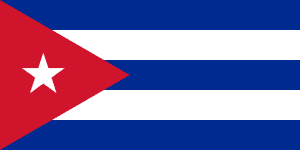
| Colors | HEX Code | RGB | CMYK |
|---|---|---|---|
| Blue | #002A8F | 0, 42, 143 | 100, 71, 0, 44 |
| White | #FFFFFF | 255, 255, 255 | 0, 0, 0, 0 |
| Red | #CF142B | 207, 20, 43 | 0, 90, 79, 19 |
The Cuban flag is made of five alternating stripes of blue and white. The order of the stripes from top to bottom is blue-white-blue-white-blue. Close to the hoist, there is a red equilateral triangle with its top pointing to the outside of the flag. On the triangle, there is a five-pointed white star.
Meaning of the Cuban Flag
The three blue stripes represent the three military districts of Cuba, while the two white stripes symbolize the purity of the patriot cause. The red triangle stood for strength and constancy. It is also thought to reflect Masonic influences, as triangles are Masonic symbols to represent equality, and they were popular in many Central American flags. The white star in the triangle represents independence.
History of the Cuban Flag
The Cuban flag was designed by exiled Cubans in New York in the 19th century when Cuba was under Spanish rule. The design was suggested by the poet Miguel Teurbe Tolón. Although the battles at Cárdenas and Playitas between 1850 and 1851 were lost, the Cuban flag was used during those battles as a symbol of independent Cuba. However, Spain lost Cuba to the United States during the Spanish-American War, and the flag of the United States was used from 1899 to 1902. Cuba raised its flag again in 1902 to symbolize its independence and sovereignty. and it stayed the same even after Fidel Castro seized control of the country. The flag is still used nowadays with no changes. In official settings, the ruling communist party flag is raised.